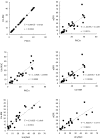Measurement of glomerular filtration rate by rapid intravenous injection of a newly developed inulin fraction
- PMID: 25650135
- PMCID: PMC4309345
- DOI: 10.2185/jrm.6.9
Measurement of glomerular filtration rate by rapid intravenous injection of a newly developed inulin fraction
Abstract
Objective: Since the conventional drip-infusion method for measuring inulin clearance (Cin) has problems related to its accuracy and performance, we explored a more accurate and concise method by rapid intravenous injection of a newly developed inulin fraction (Inulead(®)), in which spot urine sampling was omitted and the administration period of inulin was shortened from 120 to 5 minutes.
Patients and methods: Twenty seven patients (M/F: 15/12, 67.8 ± 12.9 years old) admitted to the Nephrology ward were enrolled in this study. Inulead(®), 1500 mg dissolved in 150 mL of saline, was intravenously administered in 5 minutes. Then, sequential blood samplings and urine collection were performed for 24 hours. Cins were calculated by the following three formulae: (1) a pharmacokinetic analysis using a two compartments model based on the plasma inulin concentration to determine Cin, which was the administered dose divided by the area under the curve (AUC) from 0 to ∞, (2) urinary inulin excretion divided by the AUC for 24 hours and (3) the Bayesian method using a three-point set of plasma inulin concentrations to predict the change of inulin concentration to determine Cin as in 1. These Cins were compared with levels of estimated GFR (eGFR), creatinine clearance (Ccr), serum β2 microglobulin (β2MG) and serum cystatin C (Cys C).
Results: Cins obtained by the above three methods were well correlated with each other (r. = 0.9088 (- )0.9998) and with eGFR (r. = 0.8286 - 0.8650), Ccr (r. = 0.821 - 0.864), 1/β2MG (r. = 0.631 - 0.752) and 1/CysC (r. = 0.830 - 0.857). The averaged differences of each Cin from eGFR were distributed between - 4.4 and - 4.5 mL/min.
Conclusion: Since the Cins by rapid inulin injection showed satisfactory correlation and differences with other GFR parameters, this method will be a good alternative to the drip infusion method, and may reduce the burden of patients and medical staff.
Keywords: Area Under the Curve (AUC); Bayesian method; Chronic Kidney Disease (CKD); Inulead; inulin clearance.
Figures


Similar articles
-
Beta-2 microglobulin-based equation for estimating glomerular filtration rates in Japanese children and adolescents.Clin Exp Nephrol. 2015 Jun;19(3):450-7. doi: 10.1007/s10157-014-1015-9. Epub 2014 Aug 1. Clin Exp Nephrol. 2015. PMID: 25082657
-
Simple sampling strategy for measuring inulin renal clearance.Clin Exp Nephrol. 2009 Feb;13(1):50-4. doi: 10.1007/s10157-008-0084-z. Epub 2008 Oct 1. Clin Exp Nephrol. 2009. PMID: 18827963
-
[Constant-infusion technique of inulin clearance without urine collection].Nihon Jinzo Gakkai Shi. 2011;53(2):181-8. Nihon Jinzo Gakkai Shi. 2011. PMID: 21516704 Japanese.
-
How to assess glomerular function and damage in humans.J Hypertens. 1999 Mar;17(3):309-17. doi: 10.1097/00004872-199917030-00002. J Hypertens. 1999. PMID: 10100067 Review.
-
[Glomerular filtration markers in pediatrics].Rev Med Suisse Romande. 2002 Dec;122(12):625-30. Rev Med Suisse Romande. 2002. PMID: 12611189 Review. French.
References
LinkOut - more resources
Full Text Sources
Research Materials
Miscellaneous
